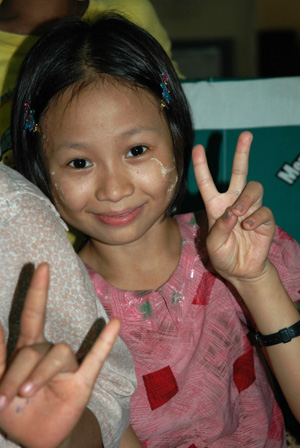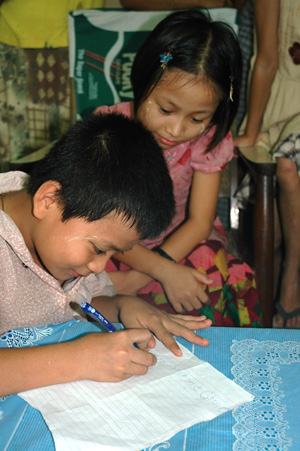The Children Who Listen with Their Eyes
A school for the deaf in Yangon is countering entrenched traditional prejudices against the disabled by helping deaf children get a head start
Tibor Krausz
The Guardian Weekly, January 13-19, 2006
Yangon

"The Lord is my shepherd and I shall not want….” Through Naw Shay Myar, Psalm 23 takes on a new, almost mystical dimension. Unable to speak, the pretty 17-year-old girl from an impoverished village in the northeast of Burma recites the psalm through signs. The words pirouette in a ballet of nimble fingers and whirl in flourishes of graceful hands, mimicking the cadences of supple verse through practiced yet heartfelt gestures.
I used to believe that deaf people were locked in an aural vacuum as if in a soundproof cell. The more fool I. At Yangon’s Mary Chapman School for the Deaf (the first and only such institution in the country), spirited little ragamuffins from five-year-olds to teenagers are chatting, joking and teasing one another. Their flying hands are aided by adroit pantomime and punctuated by super-animated facial expressions: dilated eyes stress, jiggery eyebrows exclaim, pursed lips question. With inimitable manual alacrity that would put Jim Carrey to shame, they semaphore verbal nuances and emotive inflections: the mere flashing of a hand sign by one girl elicits an instant chortling guffaw in her friend.
"We are so happy here," Naw Shay Myar says through a teacher who interprets her signs for me. "Everybody has so many friends." She’s been deaf since birth, and although she’ll be graduating soon, she plans to stay here and teach. Her two brothers have both studied in the school as well. Their parents are first cousins who married, a common practice among the close-knit Kayah people, which left its genetic mark. A missionary brought the girl and her siblings to the school. Her older brother now repairs bicycles.
"Deaf children are smart and handy. Their deafness is the only problem with them. Some become good tailors, some become skilled hairdressers, some even become taxi drivers," says Daw Hla Yi, the school's elderly treasurer. "In our culture, disabled children are considered ill-fated and often they are not well looked-after. We have to give them an opportunity to live up to their potential."
Prejudice prevails against people with disabilities. Pious Burmese Buddhists often considered birth defects as karmic debts incurred by the disabled through immoral actions perpetrated in previous lives. Only a penitential lifetime spent in silent virtuous endurance of their "curse" could liberate people from physical and spiritual imperfections in their next incarnation.

Mary Chapman took issue with that view. In 1920 the Englishwoman living in colonial-era Rangoon (later renamed Yangon) turned her house into a school for the deaf. At first, only a single student attended: parents of deaf and mute children didn’t think their offspring were worth teaching. But today, with the help of foreign donations, the school has 345 pupils. They learn lip-reading, finger-spelling, sign language, arithmetic, Burmese, English, reading, writing, and other subjects. They also receive training in sewing, embroidering, dressmaking and crocheting.
"We have a 12-year-old student who is both blind and deaf," the principal Daw Khin May Sint says of a girl who lost her sight and hearing to jungle fever. "She is very agile with her fingers. She loves weaving and produces six meters of weaving every day."
The children come from all over Burma, representing an amazing anthropological palette of minorities and hill tribes. To supplement the school's wanting finances, the children's handmade creations are sold on the premises. A mere 1,000 kyat ($1) buys a finely woven pillowcase. A student receives 30 kyat a day (or about 3 cents) in daily pocket money and 3,500 kyat for a year. That sum, for a western visitor, buys a can of Coke in a restaurant.
Ma Lei Mei, a delicate jasmine of a girl from Kachin state, detaches herself from a gaggle of children and timidly snuggles up to Daw Say Ler, her teacher, to find out what I might be doing there. "They listen with their eyes, you see," the teacher says. She strokes the little head's and adds: "They are all very dear to us, so close to our hearts, because they need us. But they don't want pity and sympathy. They want affection and empathy."
Daw Say Ler is a Christian who has worked here for 30 years. “They‘re my family. They need us and we do our best to help them.”
She strokes Ma Lei Mei’s head. “They listen with their eyes, you see.”